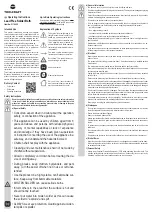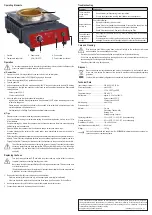
Operating Elements
1
2
3
4
5
1 Crucible
2
Temperature adjust dial
3 Power switch
I
(ON) /
O
(OFF)
4 Fuse holder
5 Power cable (not shown)
Operation
Do not keep the temperature too high over long durations as this may shorten the lifespan of the
product as well as cause liquid solder to discolour, and spit.
a) General Use
1. Prepare the solder. It is recommended to use bar solder cut into smaller pieces.
2. Make sure the power switch is OFF
(3)
before plugging in the device.
3. Connect the power cable
(5)
to a grounded wall socket.
4. Turn the power ON.
5.
Adjust the temperature
(2)
to the maximum setting “480 ºC” then add solder to the crucible
(1)
. Heating
times depend on the type and quantity of solder used as well as ambient temperature. Approximate
heating times are:
- 8 mins to reach 200 ºC
- 25 mins to reach 480 ºC
6. When the solder turns into liquid reduce the temperature.
- A guide for an effective working temperature is approximately 50 ºC above the melting point of the
solder alloy being used.
- Please take into account when additional solder is added to the solder bath a small reduction in the
overall temperature of the bath will occur.
-
Avoid splashing or overfilling. Carefully add additional solder as needed.
b) Tips
• Prepare the item to be tinned (clean any unwanted contaminants).
• If you have determined a good temperature setting for a particular application, make a note of it for
future reference.
•
For items requiring flux, first dip the component into the flux and make sure there is no excess (dripping)
before dipping into the solder bath.
• Dip and withdraw the component into the solder bath using a smooth and even motion.
• If residue develops at the surface of the molten solder, use a specialized skimmer (not included) to
remove residue.
• Solder should be replenished regularly by adding small amounts that can quickly assimilate into the sol-
der bath. This will limit any temperature variation caused by adding large amounts of solder at one time.
• Purging the Crucible: There may be times when it will be necessary to remove solder from the crucible.
The solder bath will be extremely hot during the process of purging. It is essential that you take
necessary precautions and wear appropriate PPE gear that will protect you from these high
temperatures. If in any doubt about how to safely and effectively purge the crucible, consult a
specialist.
Replacing the Fuse
Turn the main power switch OFF and allow the product and any molten solder to cool down
completely before disconnecting from the power outlet.
Never use a fuse with other specifications. Never bridge a defective fuse! This may cause a fire
or a fatal electric shock!
If the fuse blows again soon after replacing it, disconnect the workstation from the mains and ask
a technician to conduct a thorough inspection.
1. Remove the fuse holder
(4)
cover using a plus head screwdriver.
- Perform a continuity test on the fuse, e.g. with an appropriate meter (digital multimeter).
- If the fuse is defective, replace it with a new fuse of the same type. See section “Technical Data”.
2. Insert a replacement fuse until it clicks into place, then replace the protective cover.
3. Connect the workstation to the mains and switch it back on.
Troubleshooting
Problem
Suggestion
There is residue
on top of the
solder
• Use a skimmer (sold separately) to remove residue.
• If in any doubt about how to safely skim residue, consult a specialist.
Solder bath does
not turn on.
Check the following:
• Device is connected to a power outlet.
• Check if the circuit breaker has been tripped. Disconnect the device from the
power outlet, reset the circuit breaker then reconnect the device.
• Check if the fuse has blown. See section “Replacing the Fuse”.
The solder bath
is heating but is
not getting hot
enough.
• Wait longer for the device to heat up. Refer to “Melting times” in the section
“Technical Data”.
• If the temperature is still not getting hot enough, the heating element may be
damaged. Contact our technical support service or other technical personnel.
Care and Cleaning
Risk of serious buns! When cooling down, solder will solidify on the surface but will remain
molten beneath it for an extended period of time!
• Disconnect the product from the mains and allow to completely cool down before cleaning.
• Do not use any aggressive cleaning agents, rubbing alcohol or other chemical solutions as they can
cause damage to the housing and malfunctioning.
•
Clean the product with a dry, fibre-free cloth.
Disposal
Electronic devices are recyclable waste and must not be disposed of in the household waste.
At the end of its service life, dispose of the product in accordance with applicable regulatory
guidelines.
You thus fulfill your statutory obligations and contribute to the protection of the environment.
Technical Data
Input voltage / current ........................... 220 - 240 V/AC, 50 Hz
Power consumption .............................. max. 300 W
Fuse ...................................................... 3.15 A, VDE, Type: FSD
Temperature range ............................... 200 - 480 ºC
Melting time .......................................... approx. 8 - 25 min at 480 ºC:
8 mins to reach 200 ºC
25 mins to reach 480 ºC
Melt capacity ......................................... max. 1350 g
Protection class .................................... I
Material ................................................. Pot: Iron
Pot coating: Titanium alloy
Housing: Iron
Housing coating: Lacquer
Operating conditions ............................. -10 to +50 ºC, 10 – 90 % RF (non-condensing)
Storage conditions ................................ -20 to +60 ºC, 10 – 90 % RF (non-condensing)
Dimensions (W x H x D) ....................... 161 x 95 x 245 mm
Inner dimensions crucible (Ø x H) ........ 80 x 41 mm
Weight .................................................. 1.97 kg
Visit the Conrad website and search Item No.:
2176658
for information about any optional ac-
cessories, spares, or replacement parts.
This is a publication by Conrad Electronic SE, Klaus-Conrad-Str. 1, D-92240 Hirschau (www.conrad.com). All rights in-
cluding translation reserved. Reproduction by any method, e.g. photocopy, microfilming, or the capture in electronic data
processing systems require the prior written approval by the editor. Reprinting, also in part, is prohibited. This publication
represent the technical status at the time of printing.
Copyright 2020 by Conrad Electronic SE.
*2176658_v2_0220_02_dh_m_2L

















